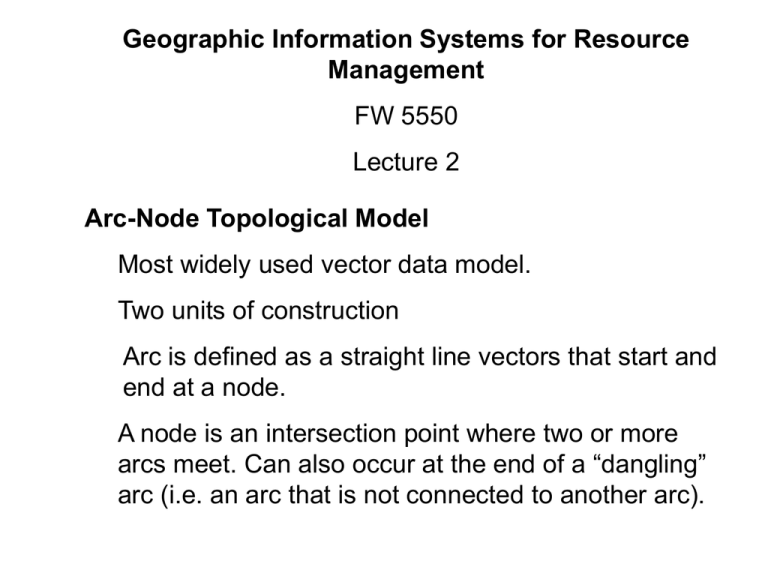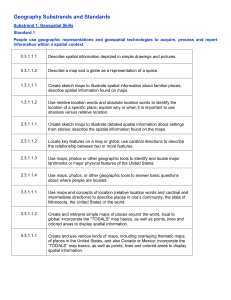Geographic coordinate systems
advertisement

Geographic Information Systems for Resource Management FW 5550 Lecture 2 Arc-Node Topological Model Most widely used vector data model. Two units of construction Arc is defined as a straight line vectors that start and end at a node. A node is an intersection point where two or more arcs meet. Can also occur at the end of a “dangling” arc (i.e. an arc that is not connected to another arc). Topology- explicit representation of spatial relationships in the vector data model. What about raster data model? Georeferencing Topology allows geocoding and address matching. Explicit vs. Implicit Representation Explicit representation- vector data. Location is described by X, Y coordinates. Precise location. Implicit representationraster data. Location is described by pixel coordinates. Location of coordinatecenter of pixel. “Wiggle Room” From: MSU Extension How well boundaries are represented in raster is function of spatial resolution. A triangulated irregular network (TIN) is a vector format data structure used for the representation of a continuous surface. Composed of irregularly distributed nodes and arcs with 3-D coordinates (x,y, and z) that are arranged in a network of non-overlapping triangles. TINs are often derived from a digital elevation model (DEM). BTW- what’s wrong with this color scheme? Using a TIN to model elevation Each triangle within the TIN assumes a constant value (elevation). Areas of little change (flat) will have fewer and larger triangles. Areas of rapid change (steep slopes) will have smaller, more frequent triangles. Continuous Data vs Discrete Data Continuous data- thematic information that varies without discrete steps Discrete data- thematic information that represents phenomena with distinct boundaries. http://support.esri.com/en/knowledgebase/GISDictionary /search Spatial or Geographic Reference Systems Provide The capability to situate measurements on a geometric body, such as the earth; establish a point of origin and orientation of reference axes; determine geometric meaning of the measurements and units of the measurements. Bottom line- need X,Y coordinates to define location The geographic coordinate system provides a measure of absolute location as opposed to relative location (street address) Once information is linked to a geographic coordinate system, it is referred to as spatial information. Coordinate systems fall into two categories- geographic and projected. It can be can be a simple grid or a complex mathematical representation. Geographic coordinate systems cover the earth’s entire surface and are a “curved system”. Projected coordinate system takes features found on earth’s curved surface and projects them to a flat surface and yet maintains topology. Also referred to as “planar”. Key Concepts- Week 1 1. What is a geographic information system? 2. How can earth surface features be represented in a GIS? 3. What is an arc? What is a node? 4. What is the difference be explicit and implicit representation? 5. Do 911 emergency systems use absolute or relative address locations in rural areas? Why? 6. What 3 geometric shapes are used in map projections? 7. Are topographic contour lines discrete or continuous data? 8. Why does a TIN portray areas of rapidly changing elevation more accurately than a DEM?











